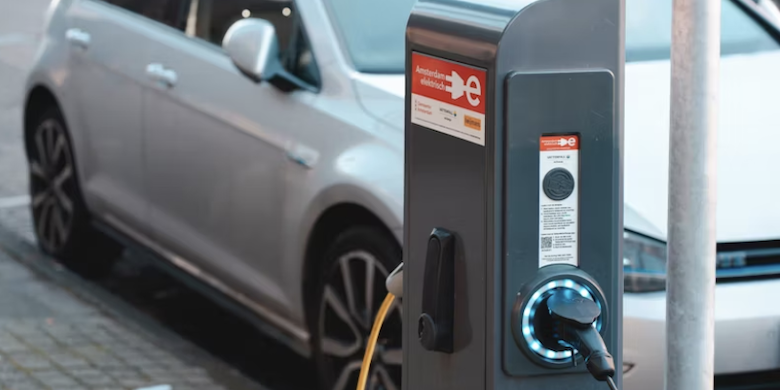Electric vehicles, typically referred to as EVs, are making inroads into the automotive market, making up about 7.6% of current new car sales in the U.S. Merchantville resident Kerry Miller is an EV owner. In this article, she shares her experience as well as those of her neighbors who also drive EVs.
I have been a contented electric car owner since 2012. Twelve years without going to a gas station! No oil changes or tune-ups. No greenhouse gas emissions. No engine noise. Dependable. Fun to drive. For me, switching to an EV was a long-awaited thrill, something that addressed my interest in both efficiency and environmental protection. But the decision to make the switch on a personal level is still a question mark for many people.
In my Merchantville neighborhood, there are at least five plug-in electric cars within a one-block radius. I spoke with four EV owners/drivers for this article. The vehicles they drive are an assortment of brands and ages – Volkswagen, Tesla, Subaru, and Hyundai. Mine is a Nissan. Their EVs span in age from one year to six, with EPA-rated driving ranges of between 170 and 300 miles. Three are leased, mine and one other are owned. The number one concern about entering the world of EV driving is RANGE. How far can I go? How often and where will I charge? Will I be stranded? Interestingly, range is an issue that drivers of combustion vehicles also face (that’s why cars have gas gauges) but they are so accustomed to it that they don’t perceive it as an impediment.
All the drivers I spoke with find that they do not get the full EPA-rated range from their vehicle; it tends to be roughly 10-20% less. The EPA range figure is a controlled average, weighted toward city driving. This does not reflect real-life driving, which is highly variable. The range of an EV is affected by the type of driving (city vs highway), ambient temperature, and the use of heat and air conditioning. Electric vehicles get less range at higher speeds and at low temperatures, more range at lower speeds and stop-and-go driving.
Like knowing when it’s time to “gas up” a conventional car, an EV driver quickly learns when to charge. The neighborhood drivers I spoke with were uniformly not stressed by their range in everyday use because they have established a pattern of charging that doesn’t generally bring them close to low. EVs sold today tell drivers where charging stations are and how many, if any, cars are ahead of them. This is very useful for long-distance travel. One driver I spoke with took a trip to upstate New York, planning on one fast charge stop but needed two and did encounter some congestion at one of the public charging stations.
Of the drivers I interviewed, only one uses public charging stations exclusively. She has incorporated the ones she uses into her routine, and charges twice a week or so. She also enjoys socializing with EV drivers while she charges! The other drivers generally charge at home. Three plug in to a regular household outlet (120 volts), using the charger cord that came with their vehicle. Overnight does it for them.
The Tesla driver has a 240-volt outlet (like what one uses for an electric dryer) installed on the house, which, with the Tesla charging cord, provides a faster (Level 2) charge. The Tesla driver has the greatest range and Tesla has the largest network of public chargers. That owner has taken long-distance trips along the east coast with no problem, getting partial charges in the time it takes to get a cup of coffee and use the facilities at a rest stop. The other drivers with smaller ranges are comfortable staying with day trips. My nine-year-old Leaf, the dinosaur of the group, is strictly for local driving, but most days that’s enough. My 50-mile daily round trip to work was a perfect match, with a comfortable range left for errands and detours. In my experience, a lot of day-to-day driving to work, school and errands is predictable and habitual, so the trick is to select a car and a charging routine that fits your usage.
All but one of the drivers I interviewed are two-car families, including mine. This is a big caveat, as the other gas-powered car is available for long trips if there is a concern that charging on the road would be a problem. All of the drivers also have driveways. People without driveway access will need to use public charging stations, which may or may not be as convenient, or as inexpensive (though still much cheaper than gasoline). The charging network is a prime target of current government funding programs and the number of charging stations should increase substantially in 2024-25.
For those interested in an EV but apprehensive, leasing is a good way to test the waters. My first Nissan Leaf was a lease, and it gave me an opportunity to confirm that EV ownership was for me. Leasing may also offer tax incentive/rebate reductions, which are taken off the top before the lease price is calculated. One EV driver I spoke with noted that, in her experience, not all salespeople at auto dealerships are highly knowledgeable (or enthusiastic) about electric vehicles. She recommends YouTube videos from users and EV nerds as a good source of information.


